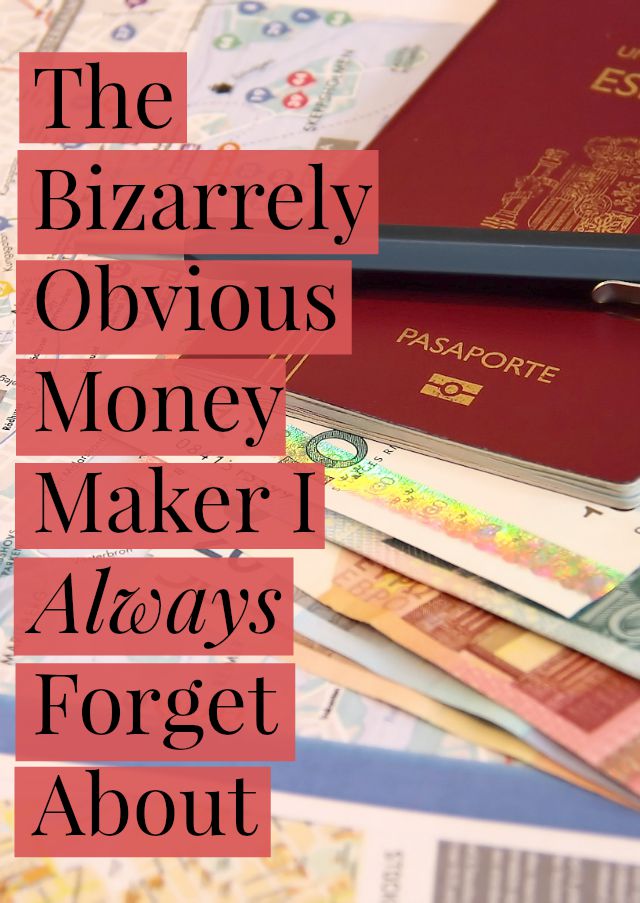
Here’s a serious question for you guys:
What sound do you make when you realize something painfully obvious? What do you do when someone says “I’m sure you’re doing this already but ….” and then says something that you should, yes, be doing BUT SOMEHOW TOTALLY AREN’T?
Depending on the source, I either:
a) tip my head back, look up at the ceiling and say “Oooooohhhhhhhh…..” in a sort of overwhelmed/nasal-y manner
b) mumble “Oh, sure yeah. Coolcoolcool. Just a sec. I’ve juuuuuust gotta run to the bathroom.” And then I make a note of said obvious-yet-somehow-not-completed-task in my phone
If you’re a human or a business owner or service provider you’ve probably had your fair share of these moments. I know I certainly have. (I’m currently rating about one per month.) And because one person’s Obvious is another person’s You’ve Just Blown My Mind With This Information, I’m going to tell you about the bizarrely obvious source of income that I just remembered – and how I made a very tidy profit with two emails.
So here’s the not-so-secret: it’s easier to sell things to people who have previously bought things from you. So if you have something new, sell it to them first at a discount.
Duh, right? And yet it took me four years of self-employment to realize this and apply it to every area of my business.
In May, my lifestyle blog Yes & Yes was gorgeously redesigned by Kim Lawler, resulting in bigger sidebar ad space. My sponsorship program is quite popular - most months I can actually pay my rent with it! (Here’s how)
But summer is slow on the internet and sponsors weren’t biting. So I emailed everyone who’d ever purchased ad space on Yes & Yes and offered them a 15% discount if they booked ad space by the end of the month.
And I made enough for two months of rent.
On the 25th, I sent a friendly email to the people who hadn’t responded, reminding them that the offer was about to expire and I made another month of rent.
“That’s great and everything, Sarah, but I don’t sell ads on my site,” I hear you say.
But you can apply this to just about anything!
Here’s how:
Step 1. Collect and group the email addresses of all your previous clients/customers/sponsors.
For me, this means one list of people who have purchased my travel ebooks, one list of writing clients, one list of blog sponsors, and one list of consulting clients.
For you, this might mean a list of people who’ve purchased jewelry from your Etsy shop, a list of graphic design clients and a list of people who bought your art prints. Or maybe it’s a list of your one-on-one health coaching clients, a list of people who bought your cookbook, and a list of people who bought your homemade jam.
Step 2. When you make something you know will appeal to one of your previous customer groups, tell them about it. Give them a discount as a thank-you for their business and as a way to test out your new offering. You’ll get business and feedback, they’ll get your shiny new offering/jewelry/jam at a discount!
Have you had any head-slappingly-obvious business epiphanies? If you have, please leave them in the comments - you never know who else needs to be reminded of those things!
photo by jorge franganillo // cc



















It does make sense but I have never done it for one reason: people usually hate being added to a list without their consent. So then, what do you do ?
Good question, Nolwenn! I don’t put these people onto my ‘general email list’ (like, the one where I send them a newsletter every week).
I just email them once or twice a year when I’ve created something I’m 99% sure they’ll like. And they’re almost always happy I got in touch and happy to have an exclusive discount!
Is that legal? I mean, in some sense, you’re putting them on a mailing list without their consent, albeit one that you don’t email too often. Especially for Etsy shops, I thought there were strict policies about that.
That’s a good question, Stacey. Honestly, I’ve never received anything other than positive responses and since I wasn’t using Mailchimp to reach out to them (I just used email addresses from my own inbox, because I’d already had interactions with these people) I didn’t really consider it an ’email list.’ But good question - and certainly something to look into!
Sarah,
I think the rule of thumb here would be client = okay, customer = not okay. And if you are emailing clients/past clients (freelance writing, design, etc.) as long as you treat these emails as personal contact there should be no problem. Your “email list” is no different than a contacts list in Gmail. However, I don’t think this same method would fly well with businesses who don’t work directly with clients.
Some examples from Mailchimp: .
Hope this helped!
That’s a great idea. Sometimes it is really risky to just send out emails to anyone on your list as it may result to negative feedback, but doing it strategically can create positive response.Thanks so much for sharing!
[…] A bizarrely obvious money maker >>> […]
You’re totally right, it’s a serious DUH moment, and the easiest thing in the world you can do to make more money without spending money. Aside from scratch-off tickets you get in your Christmas stocking. Yep.